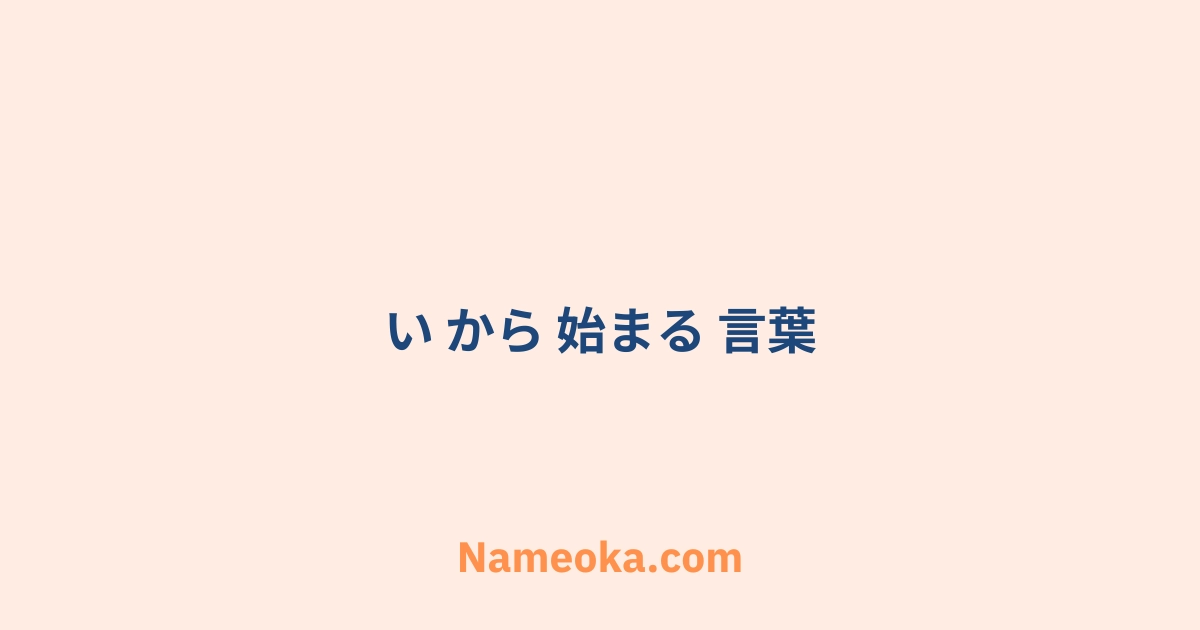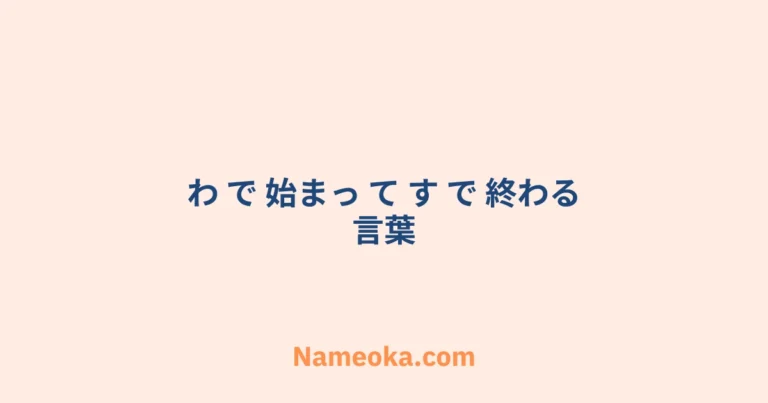いから始まる言葉の世界へようこそ。日本語には、いという音で始まる多彩な単語が存在し、それぞれが独自の意味や歴史を持っています。このような言葉を探求することで、日本文化や日常生活における新たな発見があるでしょう。この記事では、いから始まる言葉を集めて、その魅力や背景を深く掘り下げていきます。言葉の持つ力を感じながら、一緒にその奥深さを楽しんでみませんか。.

58+ い から 始まる 言葉
- 1. 犬
- 2. 家
- 3. 言う
- 4. 市場
- 5. 命
- 6. 印象
- 7. 医者
- 8. 意思
- 9. 移動
- 10. 遺産
- 11. 依頼
- 12. 印
- 13. 一緒
- 14. 意思
- 15. 衣服
- 16. 意味
- 17. 位置
- 18. 痛み
- 19. 色
- 20. 祈る
- 21. 維持
- 22. 医者
- 23. 井戸
- 24. 一度
- 25. 意識
- 26. 以上
- 27. 意見
- 28. 石
- 29. 井
- 30. 入る
- 31. 椅子
- 32. 育てる
- 33. 遺跡
- 34. 医療
- 35. 意味する
- 36. 位置する
- 37. 要る
- 38. 祈り
- 39. 行く
- 40. 忙しい
- 41. 易しい
- 42. 映画
- 43. 医院
- 44. 井上
- 45. 一般
- 46. 育て
- 47. 威力
- 48. 異常
- 49. 異様
- 50. 意図
- 51. 癒やす
- 52. 依存
- 53. 以来
- 54. 一月
- 55. 印刷
- 56. 一体
- 57. 怒る
- 58. 移る
- 59. 鋭い
Japanese Language And Culture: Understanding The Significance Of The ‘い’ Sound
The “い” sound in Japanese is a topic that may not immediately reveal its deep cultural significance to casual learners but holds interesting layers both linguistically and culturally. Here’s an exploration of its importance:
Linguistic Significance
- Phonetics and Phonology:
- “い” is one of the five basic vowel sounds in the Japanese language, represented in hiragana as い and in katakana as イ. It is pronounced as a close front unrounded vowel, similar to the “ee” in the English word “see”.
As a phoneme, “い” is fundamental to constructing syllables and words in Japanese and affects pronunciation rules, like vowel coalescence and palatalization in consonant-vowel combinations.
Grammar:
- Adjectives: “い-ending adjectives” (い形容詞) are a grammatical category. These adjectives, such as “たのしい” (tanoshii, “fun”) or “あおい” (aoi, “blue”), typically end in an “い” and have straightforward conjugation patterns.
Desu/masu form: In formal speech, verbs often end with the polite suffixes “〜ます” and “〜です”, where the “い” sound is indirectly present in the structure.
Morphology:
- Verb conjugations: Certain verb conjugations involve the “い” sound, such as the potential form (e.g., “行ける” from “行く”).
- Nominalization: The “i-form” of verbs (stem+ます) can also be derived for various grammatical constructions.
Cultural Significance
- Names and Identity:
- The sound “い” is common in Japanese names, both given names and surnames, reflecting its pervasive nature. For example, names like “さとし” (Satoshi) or “たかし” (Takashi).
The pronunciation of names often conveys cultural nuances, such as regional dialects or familial traditions.
Aesthetic Concepts:
The Japanese aesthetic often emphasizes simplicity and subtlety, which can be metaphorically linked to the simplicity of basic sounds like “い”. The concept of “Iki” (粋), often translated as “chic” or “stylish,” embodies an understated elegance, similar in philosophy to the minimalistic nature of the “い” sound.
Emotional Nuances:
- The “い” sound appears in words expressing a range of emotions and concepts. For example, “いのち” (inochi) meaning “life,” conveys a concept central to both Shinto and Buddhist thoughts intrinsic to Japanese culture.
Usage in Literature and Media
- Japanese poetry, like haiku and tanka, often showcases the use of simple sounds, including “い”, to convey deep meanings or emotions in concise forms.
- In anime and pop culture, pronunciation and playful variations of sounds like “い” can characterize speech patterns specific to certain characters or settings, adding depth to storytelling and character development.
In summary, the “い” sound’s importance in Japanese is multi-faceted, intersecting linguistics, culture, and emotion. It illustrates how something seemingly simple can embody complexity and significance in a language and culture renowned for its depth and subtlety.
Etymology And Evolution: How ‘い’ Words Have Changed Over Time
The evolution of the Japanese language is a fascinating journey that reflects its historical and cultural transformations. Focusing on words that begin with or feature the character “い” (pronounced “i”), we can see the influences of various linguistic, social, and cultural factors. Here’s a brief overview of the etymology and evolution of some key “い” words:
1. いえ (ie – House/Home)
- Old Japanese: The concept of home was expressed with variations like “いほ” (iho), referring to a dwelling or shelter.
- Classical Period: “いえ” (ie) became standardized in the Heian period (794-1185), emphasizing physical structure and familial connections.
- Modern Japanese: The word “いえ” now broadly encompasses both the physical home and the familial unit, adapting its usage to modern societal contexts.
2. いく (iku – Go)
- Old Japanese: The verb “いぬ” (inu) was used with similar meaning before “いく” became more common.
- Classical Period: By the Nara and Heian periods, “いく” established itself as the standard verb for “to go,” influenced by classical literature and poetry.
- Modern Japanese: “いく” remains widely used in its base form and various conjugations, reflecting modern movement and action.
3. いち (ichi – One)
- Old Japanese: Numerical systems were influenced by Chinese characters, with “いち” derived from “一” (one).
- Classical to Early Modern Periods: The adoption of the Chinese writing system (kanji) solidified the pronunciation “いち” in counting.
- Modern Japanese: “いち” is integral in counting and has influenced numerous expressions and idiomatic phrases.
4. いぬ (inu – Dog)
- Old Japanese: “いぬ” has been used for centuries, with consistent meaning as domesticated companion animals.
- Classical Period: Dogs held cultural and symbolic roles in literature and art, depicted consistently with loyalty and companionship.
- Modern Japanese: “いぬ” reflects both literal and metaphorical meanings, utilized in popular culture and idiomatic expressions.
5. いろ (iro – Color)
- Old Japanese: Originally linked to broader concepts of “appearance” or “beauty,” expressed with variations like “いろは” (iroha) in early poetry.
- Classical Period: Evolving to denote specific hues and shades, influenced by cultural and artistic developments.
- Modern Japanese: The word “いろ” is used to describe a vast array of colors, integral in art, design, and technology.
Cultural and Linguistic Influences
Over centuries, Japanese “い” words have been shaped by various influences:
– Chinese Characters: Introduction of kanji during the 5th century profoundly impacted the vocabulary and writing system.
– Buddhism and Chinese Literature: Contributed philosophical and poetic dimensions to language development.
– Western Influence: Post-Meiji Restoration (1868), the adoption of Western concepts and terms led to new “い” words or expanded meanings.
Understanding these words provides insight into how language adapts over time in response to cultural shifts, technological advances, and social change, maintaining their relevance in Japanese society today.
Exploring Idioms And Expressions: The Role Of ‘い’ Words In Daily Conversations
In Japanese, the syllable ‘い’ (pronounced ‘i’) plays a significant role in various idioms and expressions that are commonly used in daily conversations. These expressions often carry cultural nuances and convey meanings that go beyond their literal translations. Here are some examples and their roles in everyday communication:
- いい加減にする (ii kagen ni suru):
- Literal Meaning: Do it properly.
Usage: This expression is often used to tell someone to stop what they’re doing or to be more serious. It can also suggest doing something in moderation or the right amount, depending on the context.
息が合う (iki ga au):
- Literal Meaning: Our breaths match.
Usage: This idiom is used to describe people who work or interact well together, almost as if they can anticipate each other’s actions and thoughts.
意気投合 (iki tougou):
- Literal Meaning: Spirits combine.
Usage: This expression is used when people hit it off well, sharing mutual understanding or interests almost immediately upon meeting.
生き甲斐 (ikigai):
- Literal Meaning: Something worth living for.
Usage: This concept is crucial in Japanese culture, relating to what gives a person’s life meaning, motivation, and happiness.
痛し痒し (itashi kayushi):
- Literal Meaning: Painful yet itchy.
Usage: This phrase is used to describe a situation with both pros and cons, where a decision or situation is both beneficial and troublesome at the same time.
いざ鎌倉 (iza kamakura):
- Literal Meaning: Now to Kamakura.
Usage: Originating from historical context, it refers to the readiness to respond to an emergency or duty. Today, it implies being ready to jump into action when needed.
言わぬが花 (iwanu ga hana):
- Literal Meaning: Not saying is a flower.
- Usage: This expression is similar to “silence is golden,” suggesting that sometimes it’s better to remain silent than to say something potentially harmful or unnecessary.
These idioms and expressions highlight the expressive and nuanced nature of the Japanese language. They illustrate how cultural values, social interactions, and emotions are woven into everyday conversations through specific and often beautifully crafted language. Understanding these expressions not only enhances language proficiency but also offers deeper insight into Japanese culture and communication styles.
よくある質問
いから始まる言葉にはどんな単語がありますか?
いから始まる言葉には、犬、いちご、イノシシなどがあります。これらの言葉は日常生活でもよく使われます。.
いから始まる言葉の例は何ですか?
いから始まる言葉の例として一番人気なのは、いちごです。その他にも、石(いし)、池(いけ)などがあります。.
子供向けのいから始まる言葉はありますか?
はい、いから始まる言葉の中で子供向けには、いぬ(犬)、いろ(色)、いす(椅子)などがあります。これらの単語は遊びや絵本でもよく見かけます。.












